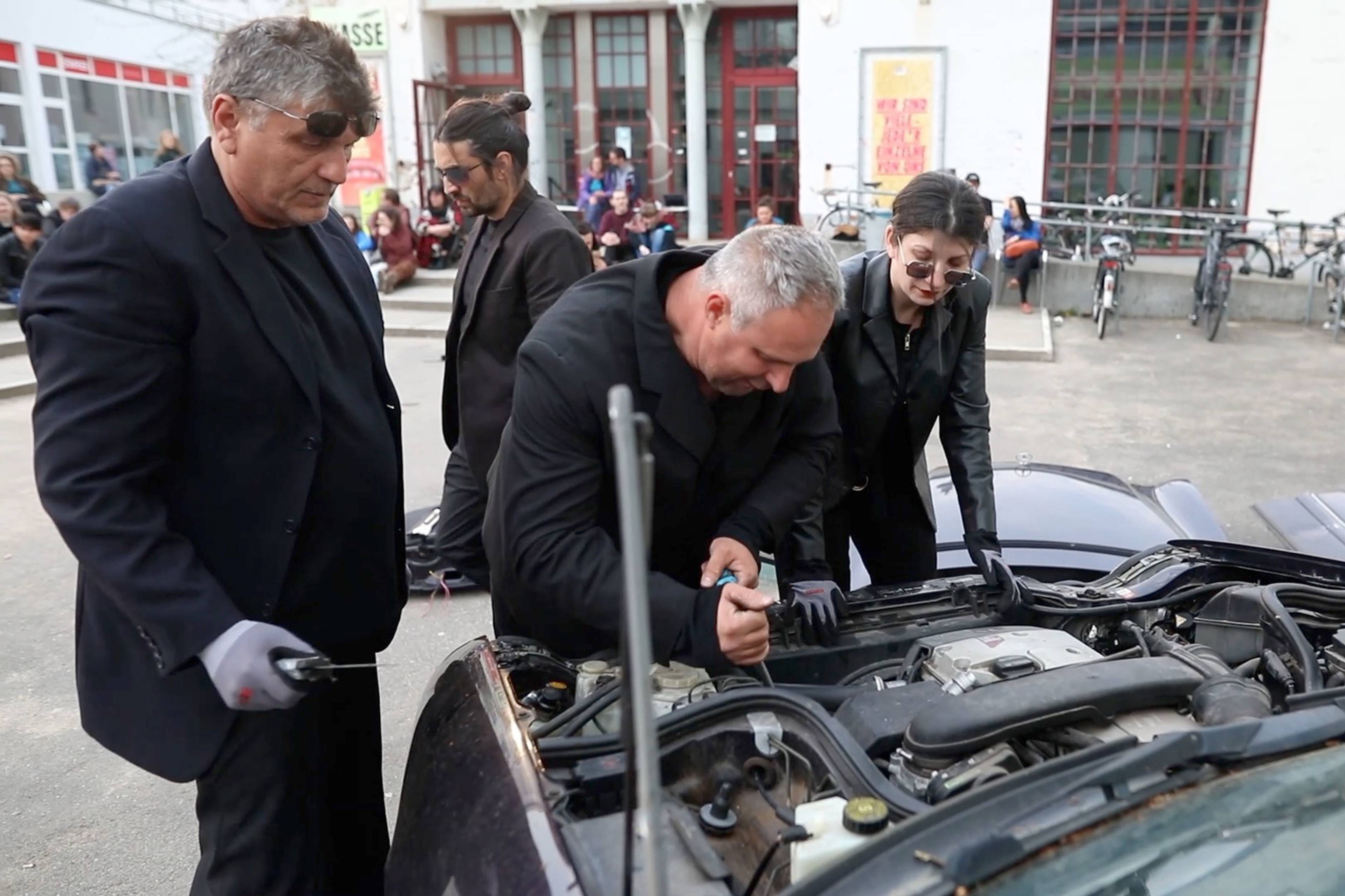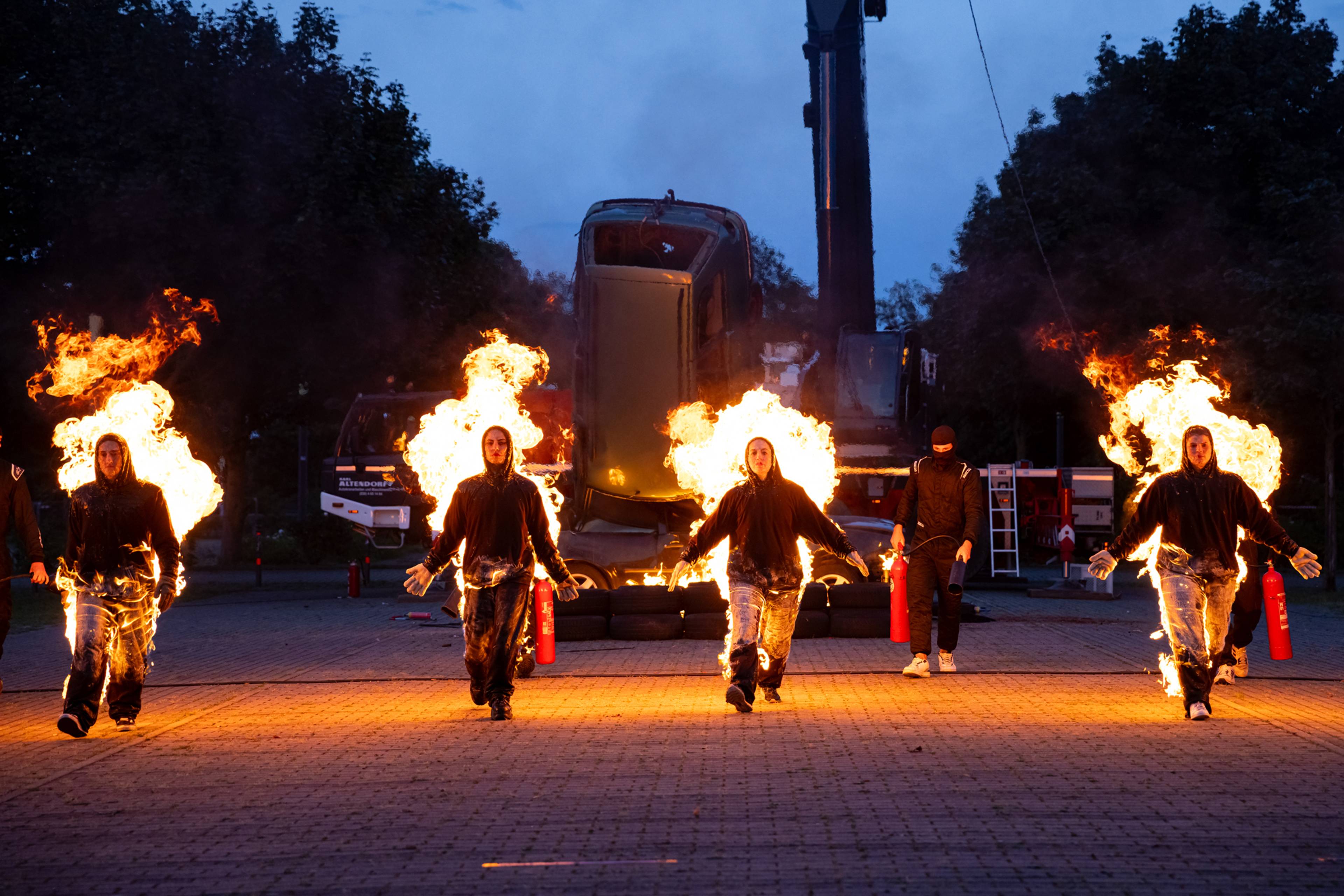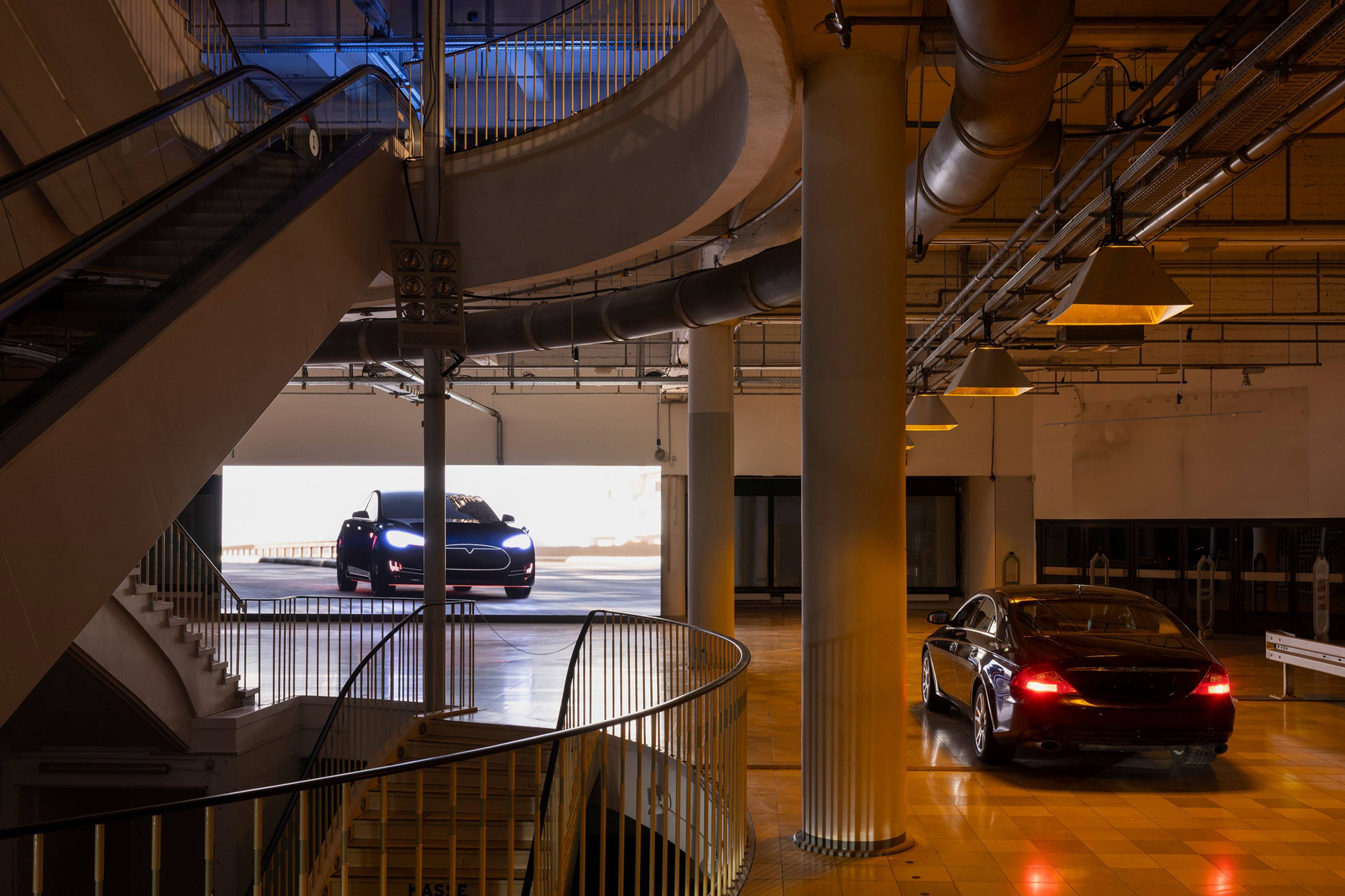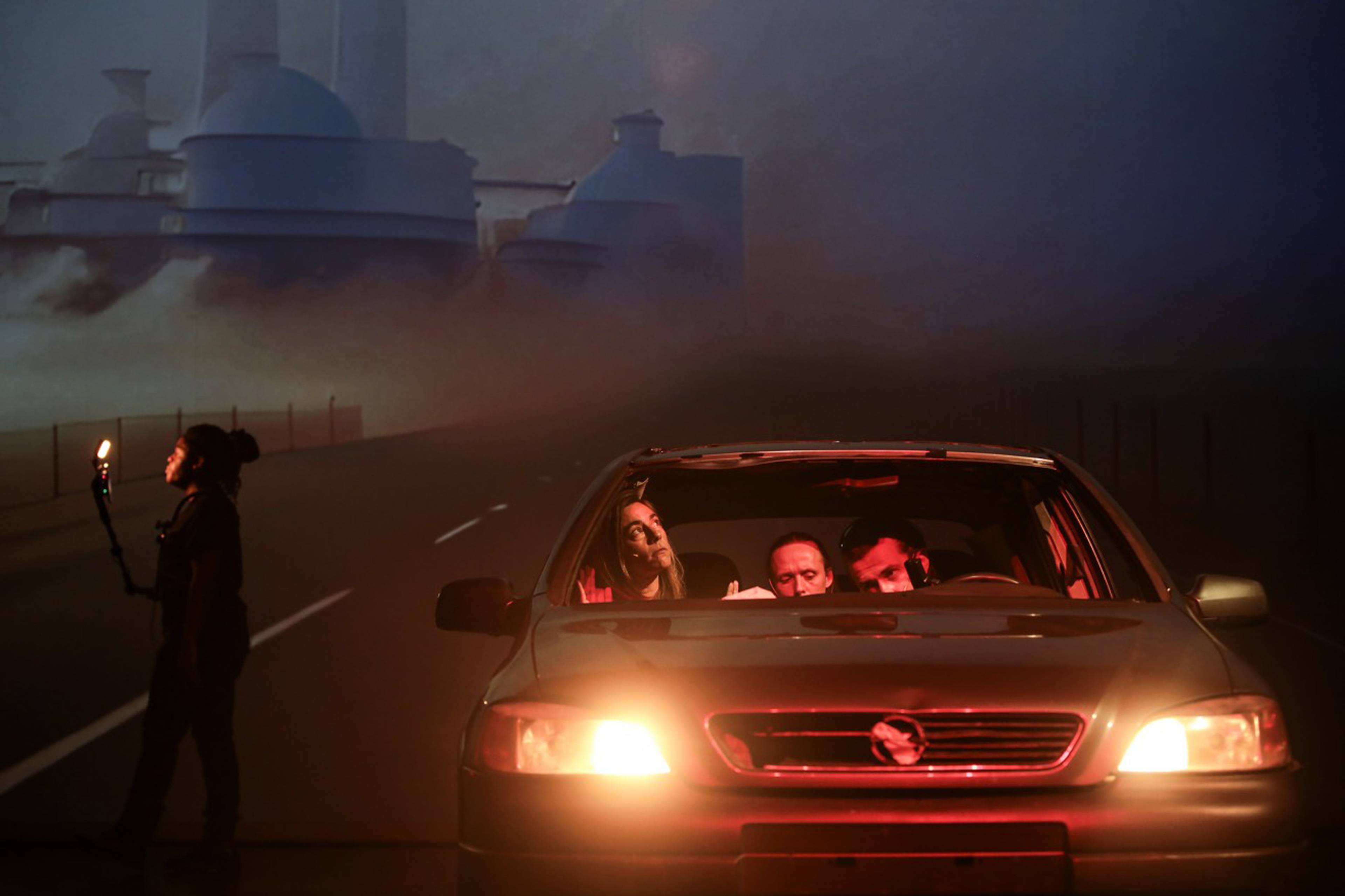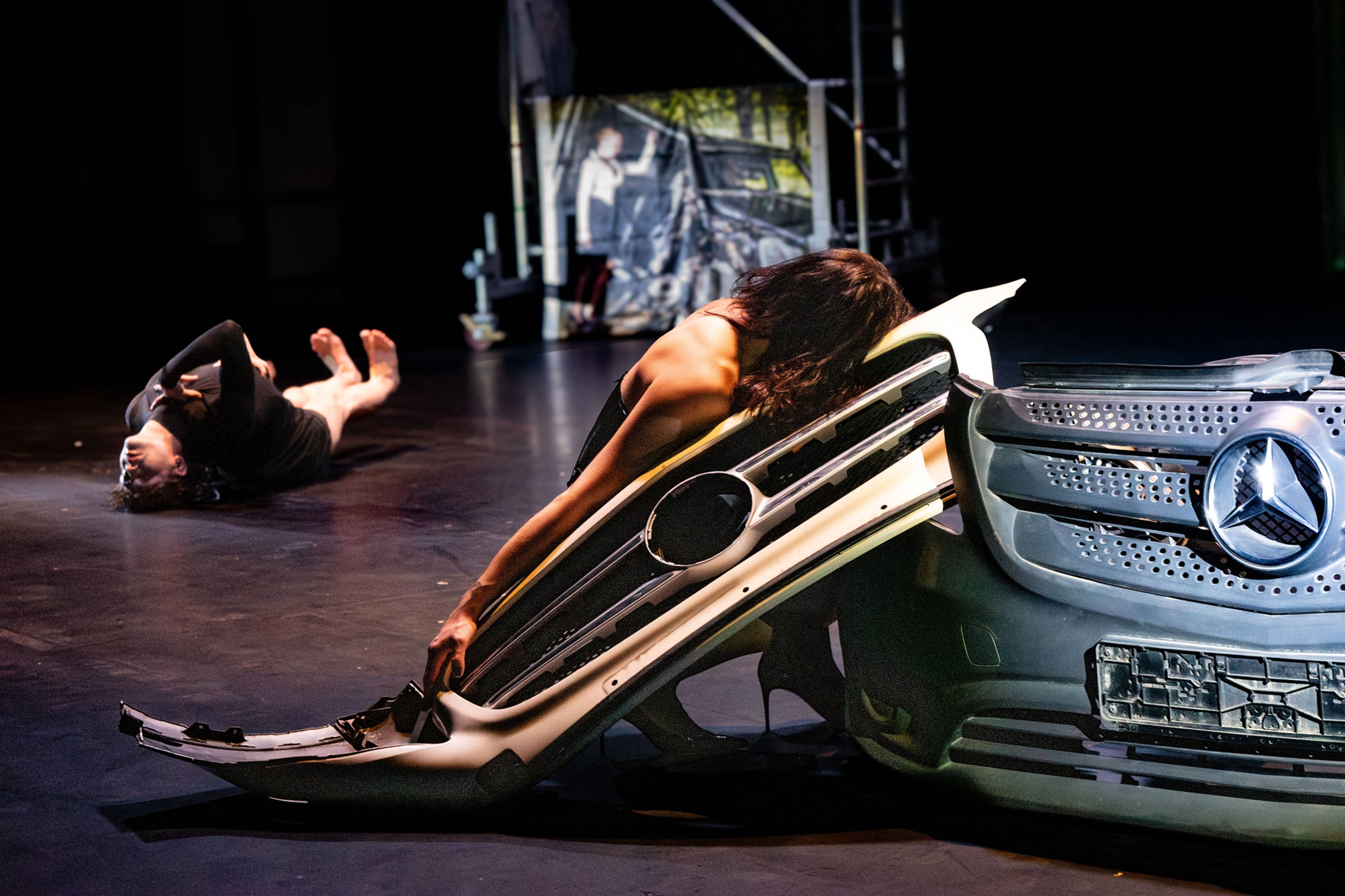Lana Del Rey’s one true love roars like a revving white Mustang. Frank Ocean’s relationships unfold like a sleek white Ferrari. Charli XCX struggles to keep pace with her lover, speeding away like a white Mercedes. Today, when the car is no longer a phallic object of pride, but a toxic asset complicit in the destruction of nature, these metaphors might seem out of touch. Yet, it is not just an obsession of pop musicians; numerous artists have recently followed the same “mechanophilic” impulse. In gallery spaces or on theatrical stages, they caress, copulate with, or destroy these vehicles; that is, they treat cars the way people treat each other. But why humanize such contentious objects?
Florentina Holzinger’s spectacular works, instantly recognizable by the convergence of naked femmes with motorized technologies, stand at the forefront of this aestheticization. In Scrap Étude: An Étude for Extinction (2023), staged in the parking lot of Berlin’s Olympic Stadium, a racing car balances precariously on two wheels – a risky maneuver known as “skiing” – while a musician straddled the passenger-side door, drawing a bow across the sideview mirror like a double bass. Melding associations with fearless Amazons and the musical avant-garde, one could read it as a feminist reclamation of drifting. In another scene, an empty sedan hung from a massive, phallic crane. At a conductor’s cue, it was released and, crashing onto a second vehicle, engulfed the nearby stuntwomen in an explosion, who were promptly extinguished by a brigade of men – the human body become just a cog in a Rube Goldberg machine. Holzinger, in her own words, aims to make motorized objects into “something sublime,” merging them with organic bodies into a single entity (what her set designer, Nikola Knežević, calls “hybrid-objects,” after philosopher Bruno Latour). In these high-budget spectacles, though, where safeguarding participants from technology is often more costly than the technology’s very usage, such hybridizations do not equalize humans and machines, but aestheticize the coercion of flesh by motor. To render technological force autonomous, almost divine, is not an emancipatory act, but a ritualistic surrender to the vassalage of cars. A blockbuster of destruction for its own sake.
Florentina Holzinger, Scrap Étude: An Étude for Extinction, 2023. Performance documentation, Parkplatz am Olympiastadion, Berlin
Both courtesy: the artist and neon lobster. Photos: Mayra Wallraff
The merger or invasion of the human body by machines is familiar to us from movies like David Cronenberg’s cautionary tale Crash (1996) and Julia Ducournau’s nihilist body horror Titane (2021). But how would it look to reverse that process – to create a car that truly emulates us? To mimic organic thought, no single machine would suffice; it would take a community of automatons with a culture as rich and intricate as human civilization. Lawrence Lek’s NOX (2023) was one such attempt, transforming an abandoned Berlin mall into a rehab center for damaged, hallucinating cars. Visitors, equipped with synchronized headphones, could wander the installation’s three floors of dissected vehicles, listening to the confessions of Enigma76, a four-tired courier that started malfunctioning during their umpteenth delivery mission. In one scene, this self-driving car gazes over a graveyard of obsolete models – its evolutionary predecessors – and, in recognizing their own replaceability, experiences an existential crisis. Technology in NOX is not a self-generating deus ex machina; it is a congealed labor, a cumulative repository of skill, experience, and scientific knowledge from generations of humans past. Yet, Enigma76 must also inherit all the flaws in the divisions of human work, such that to humanize a car is to show us how we ourselves have been dehumanized by a neo-feudalist mode of production.
If autonomization inclines towards animistic endowment, Agnieszka Polska’s The Talking Car, staged in 2024 at HAU, Berlin, dismantles such impulses with satire. The play follows the misadventures of three unlikely companions: a woman in labor, an eternally young chimney sweep, and a man who, raised by machines, is jobbed as a rubbish analyst, all trapped inside a self-driving smart car named Marlene. In this technocracy – devoid of any other vehicles and haunted by lingering ghosts – the characters initially view the car as an authority, turning to her with questions and requests. However, as Marlene’s responses grow confusing, bordering on psychoanalytic sessions about the passengers, their faith begins to waver, and they slowly realize they are drifting farther from the maternal hospital that was their destination. Sharpening the materialist critique implicit in Lek, Polska stands the vehicle, not on its head, but on its feet, for all the three characters could be read as allegories of different types of labor – reproductive, manual, and intellectual. In a high-tech society where production is shrouded in proprietary know-how, opaque even to its own workers, the smart car, a symbol of neoliberal progressivism, has become fully autonomous from human control. The passengers’ experience of ragpicking and chimney cleaning hint at our direction of travel: not post-capitalist utopia, but towards new forms of exploitation, reminiscent of Victorian or medieval pasts.
Lawrence Lek, NOX, 2023. Installation view, Kranzler Eck, Berlin. Courtesy: the artist and LAS Art Foundation. Photo: Andre Rossetti
Agnieszka Polska, The Talking Car, 2024. Performance documentation, BoCA Lisbon. Courtesy: the artist. Photo: Bruno Simao
As products of the totality of social relations, cars participate not only in the division of labor, but also in its racialization. In their book White Skin, Black Fuel (2021), Andreas Malm and the Zetkin Collective trace German automotive’s inheritance back to the autostrada novels and autobahn paintings of fascism and Nazism and the Third Reich’s labor camps, a genealogy that continued through a post-War Wirtschaftswunder powered by so-called “guest workers.” In two works co-produced with Sophiensæle, Berlin, Göksu Kunak staged critical commentaries on the ongoing fate of migrants in Europe within acts of car idolatry. VENUS (2023) replaces the white female model of automotive ads with performers of diverse backgrounds and gender identities, whose tableaux-vivant poses reference mechanophilic works like Chris Burden’s performance Trans-Fixed (1974) and Tunç Okan’s film Mercedes Mon Amour (1992), sometimes set to Turkish-speaking hip hop. In INNOCENCE (2024), Kunak and others dance in the wake of 90s pop export Mezdeke, with self-orientalizing movements that service commodified, colonial projections of “Turkishness.” “What if they take over our cars, our Benz, our highways, and pollute the streets with their music?” Kunak asks sarcastically in one of their scripts. Anticipating “remigration” and expulsion en masse from the core Western countries, a single BMW or Mercedes-Benz can model the entire cycle of migrant labor: exploited, racialized, exoticized, alienated, and, finally, deportable.
Perhaps the least spectacular of these works, Selma Selman’s Mercedes Matrix (2019) is also the least uncompromising in its critique of machinic allure. For her performance, the documentation of which was presented at her 2023 solo show at Gropius Bau, Berlin, the Roma artist invited family members, all clad in black jackets and sunglasses, to dismantle scrapped cars in front of an audience. What looked like artistic vandalism was plain manual labor, separating junk from reusable parts. Its artistic method echoes Dziga Vertov’s “Communist decoding of reality,” akin to the Soviet film director’s use of reverse motion to visualize the unseen stages of bread production, rather than its finished display on a store shelf. The car, of course, has a much longer life cycle than bread. Beyond production, distribution, circulation, and consumption, it has an afterlife as waste trucked around Europe’s racialized hierarchy of labor, where non-whites and the geographical peripheries are tasked with handling decaying, carcinogenic materials. Stripped of their last animistic qualities, the cars reappear in Mercedes Matrix as so much rusted-out scrap.
Göksu Kunak, INNOCENCE, 2024. Performance documentation, Sophiensæle, Berlin. Courtesy: the artist. Photo: Gino Henry José
In his famous Maschinenfragment (“Fragment on Machines,” from Capital, Vol. 3, 1894), Karl Marx reminds us that nature does not build machines – these are “natural material transformed into organs of the human will.” Whether a sleek smart device or junkyard metal, the car remains part of a larger machinery that turns its users into resources for its insatiable expansion. The act of humanizing a car is, therefore, inherently dialectical: If we name machines Marlene or Enigma76, we ought also to start calling humans cars. And the critical implications of art’s mechanophilia go further still: Pushed to the brink of environmental catastrophe and global warfare by seemingly autonomous military-industrial complexes and irrational market mechanisms, is there a case for evolving cars into ends in themselves? Should they merit our compassion when so many victims of a blazing imperialist juggernaut still go without? And how can a critique of car fetishism avoid recreating new aesthetic totems or nihilist spectacles? If we try to answer these questions, we might still find an exit ramp – before we accelerate straight into a planetary wreckage.
___


